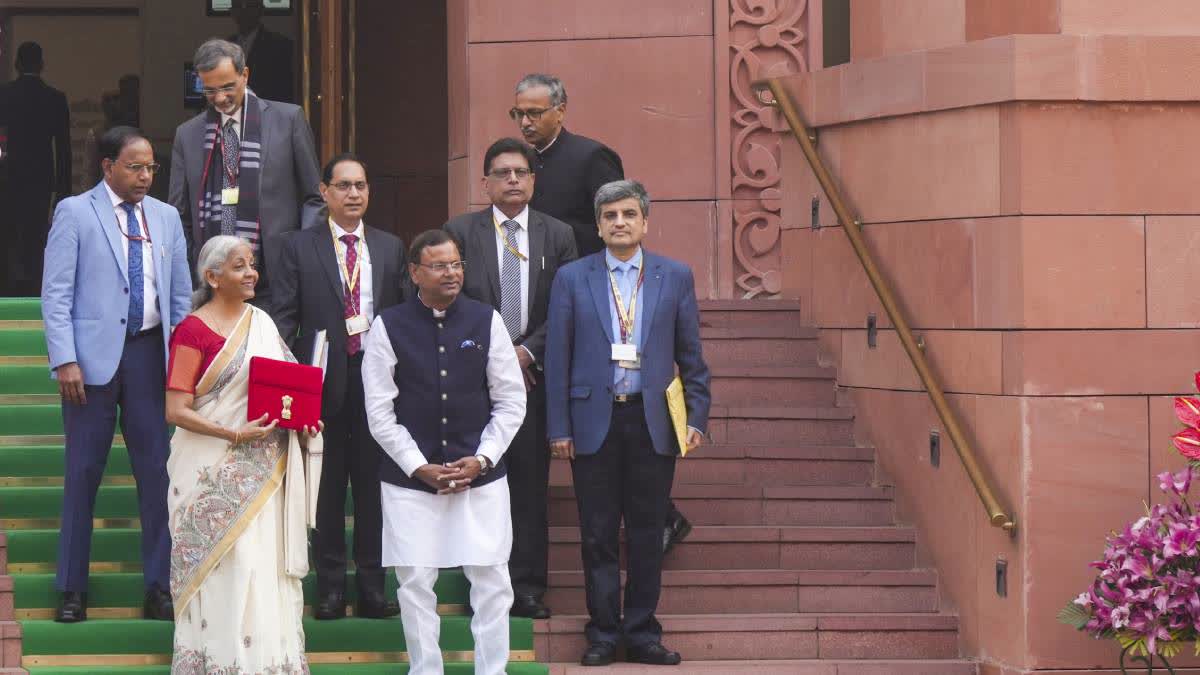New Delhi: With the government’s main focus being on the revival of the domestic economy in a tough global economic situation, the allocation for the Ministry of External Affairs in the Union Budget 2025-26 tabled by Finance Minister Nirmala Sitharaman on Saturday saw a significant trimming down. This year, Sitharaman has proposed an allocation of Rs 20,516.61 crore to the External Affairs Ministry, significantly lower than last year's revised estimate of Rs 25,277.2 crore.
"One way of looking at it is that the government is prioritising the revival of the domestic economy," Harsh V Pant, professor of International Relations with King's India Institute at King’s College London and vice-president (studies and foreign policy) at think tank Observer Research Foundation, told ETV Bharat. "The Indian economy has to navigate through choppy waters," Pant added.
Pant said that given how the world is looking inward, for India, it is important to drive domestic growth. "Unless the domestic economy is strong, we cannot afford to play the role of global leader," he said.
The Budget lays stress on agriculture, micro, small and medium enterprises (MSMEs), infrastructure, education and healthcare. It proposes significant funding for defence, rural development, education, healthcare, railways and highways signifying the government's commitment to job creation and long-term economic stability.
Pant said the government aims to reduce the fiscal deficit from 4.8 per cent in the current year to 4.4 per cent in the next fiscal. "Then, in that case, expenditure also has to be cut down in several areas," he said.
The current fiscal allocation of Rs 5,806.48 for the "Aid to Countries" category to the External Affairs Ministry is lower than the previous Budget which set aside Rs 5,483 crore for this purpose. This funding supports multilateral and bilateral aid initiatives, extending assistance to neighbouring countries as well as developing nations in Africa, Central Asia, South Asia, and Latin America. It also covers aid for disaster relief and humanitarian efforts.
Aid For Bhutan, Nepal
Expectedly, Bhutan is the biggest beneficiary of the aid with an allocation of Rs 2,150 crore, which is, however, lower than the Rs 2,543.48 crore allocated in the previous fiscal. Nepal seconds Bhutan with Rs 700 crore aid, same as last year.
Aid For Maldives
Following the downturn in the bilateral relationship with Maldives post-Mohammed Muizzu's presidency, the aid has gone up for the nation in the Indian archipelago. The development aid allocated for the Maldives stands at Rs 600 crore, compared to Rs 470 crore last year. This comes amidst an economic crisis and signing investment pacts with China and Turkiye which has raised concerns of New Delhi.
External Affairs Ministry spokesperson Randhir Jaiswal, during a media briefing on Friday, said India was in close touch with Maldivian authorities on the situation facing them.
"Recent agreements (an obvious reference to the pacts with China and Turkiye) that are likely to result in revenue loss for the Maldives government are obviously a matter of concern and do not bode well for the long-term fiscal stability of the country. We would obviously need to take that into account while framing our own policies," Jaiswal said.
Aid For Sri Lanka
Sri Lanka, a country that faced a huge financial crisis three years ago and for which India played an important role in providing debt relief, has been allocated a development aid fund of Rs 300 crore, the same as last year. This comes after Marxist-leaning Anura Kumara Dissanayake was elected as President last year. Dissanayake has since made his first state visit to India after assuming office. Though Dissanayake visited China and inked investment deals, Indian developmental aid for the island nation remains unabated as reflected in the Budget.
Ties With Bangladesh
Ties between India and Bangladesh are delicately poised following the ouster of Prime Minister Sheikh Hasina in the face of a mass uprising and the installation of an interim government with Nobel Laureate Muhammad Yunus as the Chief Advisor. New Delhi has also been repeatedly expressing grave concerns over reports of attacks on minorities in the wake of the regime change. However, the government has chosen not to cut down on development aid for its eastern neighbour and has kept it at Rs 120 crore, the same as last year.
Myanmar
Myanmar, the other eastern neighbour, has been facing a violent resistance movement against the junta as a result of which work on key India-funded infrastructure projects has been stalled. The developmental aid allocated for Myanmar in this year's Budget is Rs 350 crore, down from last year's revised estimates of Rs 400 crore.
Afghanistan
Though New Delhi refuses to recognise the Islamic fundamentalist Taliban regime in Kabul, it nevertheless has continued with its developmental work and humanitarian assistance in Afghanistan. In recent times, there have been signs of India and Afghanistan cosying up to each other. While the Taliban has deputed its representative to take charge of the country's consulate in Mumbai and is reportedly in the process of deputing two more diplomats, the recent meeting between foreign secretary Vikram Misri and acting Taliban foreign minister Amir Khan Muttaqi also drew global attention. The Budget has doubled the developmental aid to Rs 100 crore from last year's revised estimates of Rs 50 crore.
The SAGAR Nations
Though India is seeking to increase its footprint in the Western Indian Ocean under the Security and Growth for All in the Region (SAGAR), development aids for countries in the region have been pared down in line with the truncated allocation for the External Affairs Ministry. While the amount allocated to Mauritius is Rs 500 crore, lower than last year's revised estimate of Rs 576 crore, the amount for the Seychelles is Rs 19 crore, which is around half that of last year's Rs 37 crore. These apart, a combined amount of Rs 225 crore has been allocated as development aid funds for other African countries, which is slightly higher than last year's Rs 200 crore.
Allocation For Autonomous Bodies
A total amount of Rs 394.18 crore has been set aside for autonomous bodies functioning under the External Affairs Ministry. These include the Indian Council of Cultural Relations (ICCR), the Indian Council of World Affairs (ICWA), the Society for Research and Information System for Non-Aligned, Other Developing Countries (RIS) and the India Centre for Migration. The expenditure caters for grants-in-aid salaries and grants-in-aid-general.
Other Central Sector Expenditure
Apart from the autonomous bodies, under the 'Other Central Sector Expenditure' head, an amount of Rs 6,214.2 crore has been allocated, a significant decrease from last year's Rs 10,638.7 crore. This caters to the discretionary expenditure, Commonwealth Secretariat, international organisations, UN organisations, South Asian Association for Regional Cooperation (SAARC) secretariat, and construction of South Asian University and Nalanda International University. This also caters to the maintenance cost of aircraft of Air India for VVIP travel, demarcation of boundaries, celebration of Pravasi Bhartiya Divas, Kailash Mansarovar Yatra, Indian Society of International Law, support for Institutes of Chinese Studies, Centre for Land Warfare Studies and Centre for UN Peacekeeping and expenditure on Foreign Service Institute. This head also includes funds provided to the Exim Bank against the invocation of central guarantees for loans to other countries, which are considered doubtful debts.
The Budget proposal for the Ministry of External Affairs marks a notable recalibration in the government's spending priorities. With a clear emphasis on boosting domestic economic growth, the decision signals a deliberate move to address homegrown challenges and stimulate local industries.
Also Read:



